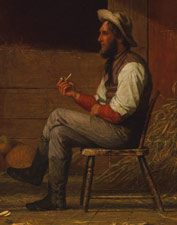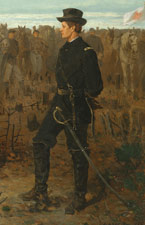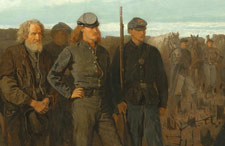New Connections appear every Wednesday. Sign up for a reminder.
Senior vice president Harold Holzer reflects upon works dating from the tumultuous period in American history of Abraham Lincoln.
 1280852
1280852 8561024
8561024 1126820
1126820 8761024
8761024 9341024
9341024 10591024
10591024 10011024
10011024 9961024
9961024 8301024
8301024 1218848
1218848 8291024
8291024 1280805
1280805 1280699
1280699 7271024
7271024 7301024
7301024 7271024
7271024 1280808
1280808 11211024
11211024 12761024
12761024 748767
748767 12761024
12761024 1280960
1280960 7681024
7681024 8051024
8051024 1280960
1280960 1280808
1280808 6591024
6591024 1280833
1280833 1280852
1280852
I'm Harold Holzer, I'm the Senior Vice President for External Affairs at the Met, and I also write books about Abraham Lincoln and the Civil War.
I first became interested in Abraham Lincoln by accident. I was a student in the fifth grade in Queens, my romantic beginnings, and we were assigned to pick a name from our teacher's hat, literally.
I picked Lincoln, needless to say, and my friend who was right behind me picked out Genghis Khan, and he became a rock and roll promoter, so you never know. These are very powerful influences.
I start always with the first works of art for which Abraham Lincoln sat. He posed for a life mask in Chicago in the spring of 1860, and the sculptor put straws in his nostrils and covered his face in plaster, and the plaster hardened really tight. He couldn't get the mask off of Lincoln's face, and Lincoln motioned that he would do it, and he pulled and pulled and pulled hairs in his temple out
with the mask. But it brought tears to his eyes, and the sculptor remembered that he was the first subject he made cry. After Lincoln was nominated for the presidency two months later, the sculptor came to Springfield, Illinois
to cast Lincoln's hands in plaster. But, his right hand was so swollen from the thousands of handshakes, that it swelled beyond recognition. So Volk said, "Maybe you should hold something."
The next thing Volk heard was some sawing coming from the wood shed. Lincoln was actually sawing a broom handle.
So the Met owns the right hand in bronze, and it shows the swollen hand. And recently
we acquired a photograph that was made at exactly this same time. If you look very carefully for Lincoln's
right hand, you'll see he's covering it with his left hand. It's really unique and it hearkens back to that transcendent moment when Lincoln went from dark horse to nominee and likely president in just a few days.
Of course the country was changing rapidly, and we talk about the political climate being so heated these days. It was much more heated in 1859, 1860.
Martin Johnson Heade's Approaching Thunder Storm is often described as a scene that he had witnessed in New England, but in fact, it's also a reflection of the portent of war.
The Met collection also reflects the efforts of the common soldier and their struggles to preserve the union and end slavery.
One of the most extraordinary is called A Little Bit of War History, painted right after the war, but showing the evolution of the life of one African American and his progress through the war
and a reminder that the end of slavery, the beginnings of equal rights, were not achieved simply by the stroke of Lincoln's pen, but by African Americans fighting
for their their own freedom. So this was a moment when black contributions were recognized, but it was a brief moment in time.
On the other side of the coin we have The Veteran in a New Field. You get the feeling, or I do, that the wheat is a symbol for the return to prosperity. Yet at the same time
he's using a scythe, and one cannot help think about the grim reaper. And that reminds at least this viewer of the fact that so much blood had been shed in the war to make this renewal possible.
But just as a reminder that the experience of renewal doesn't apply to everybody: Eakins' painting of what he calls a Negro Boy Dancing. You look at three generations of a family. What fascinates me is that in the background is
a medallion portrait of Abraham Lincoln and his son, Tad. And we know that many African American homes had pictures of Lincoln. But what is it saying to us that it's not just Lincoln, it's Lincoln and his son? Is it saying that
African American multigenerational opportunity is not the same as presidential white opportunity? Maybe I'm reading too much into it, but the inclusion of Lincoln is a symbol both of appreciation and limitation.
Talking It Over is not a Civil War painting and it's not a Lincoln painting. You've got two people discussing life. But darned if the
older fellow on the left is not the spitting image of George Washington.
And on the right, the younger, bigger, and maybe a little bit more vigorous farmer bears an astonishing resemblance to Abraham Lincoln.
To me it's about American history and its first hundred years.
These serious, reflective pieces, I think, they give assurance that this is something that's still in the public mind.
There was glory attached to the war, but at what incredible, unfathomable cost.
How long did it take us to deliver on the promise of equality and opportunity? The debate continues, and it's a good reminder to see it through the lens of
artistic tradition and experimentation.
 |
 |
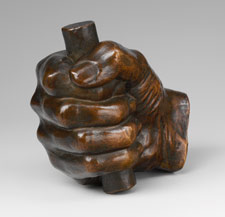 |
 |
 |
 |
 |
 |
 |
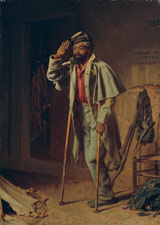 |
 |
 |
 |
 |
Works of art in order of appearanceLast Updated: June 22, 2015. Not all works of art in the Museum's collection may be on view on a particular day. For the most accurate location information, please check this page on the day of your visit. |
||
 |
Abraham Lincoln 1863, printed 1901 Alexander Gardner (American) Gelatin silver print Warner Communications Inc. Purchase Fund, 1976 (1976.627.1) More information: The Collection Online Not on view
|
 PhotographsSecond Floor
PhotographsSecond Floor |
 |
Life Mask of Abraham Lincoln 1860, cast 1886 Leonard Wells Volk (American) and Augustus Saint-Gaudens (American) Bronze Purchase, Jonathan L. Cohen and Allison B. Morrow Gift and Friends of the American Wing Fund, 2007 (2007.185.2) More information: The Collection Online Not on view
|
 American Paintings and SculptureFirst and Second Floors
American Paintings and SculptureFirst and Second Floors |
 |
Right Hand of Abraham Lincoln 1860, cast 1886 Leonard Wells Volk (American) and Augustus Saint-Gaudens (American) Bronze Purchase, Jonathan L. Cohen and Allison B. Morrow Gift and Friends of the American Wing Fund, 2007 (2007.185.1) More information: The Collection Online Not on view
|
 American Paintings and SculptureFirst and Second Floors
American Paintings and SculptureFirst and Second Floors |
 |
Abraham Lincoln 1860 William Marsh (American) Salted paper print from glass negative Gilman Collection, Purchase, Joyce F. Menschel Gift, 2005 (2005.100.89) More information: The Collection Online Not on view
|
 PhotographsSecond Floor
PhotographsSecond Floor |
 |
The Last Moments of John Brown 1882–84 Thomas Hovenden (American) Oil on canvas Gift of Mr. and Mrs. Carl Stoeckel, 1897 (97.5) More information: The Collection Online Not on view
|
 American Paintings and SculptureFirst and Second Floors
American Paintings and SculptureFirst and Second Floors |
 |
Approaching Thunder Storm 1859 Martin Johnson Heade (American) Oil on canvas Gift of Erving Wolf Foundation and Mr. and Mrs. Erving Wolf, 1975 (1975.160) More information: The Collection Online Not on view
|
 American Paintings and SculptureFirst and Second Floors
American Paintings and SculptureFirst and Second Floors |
 |
Rainy Day in Camp 1871 Winslow Homer (American) Oil on canvas Gift of Mrs. William F. Milton, 1923 (23.77.1) More information: The Collection Online Not on view
|
 American Paintings and SculptureFirst and Second Floors
American Paintings and SculptureFirst and Second Floors |
 |
A Bit of War History: The Contraband 1865 Thomas Waterman Wood (American) Oil on canvas Gift of Charles Stewart Smith, 1884 (84.12a) More information: The Collection Online Not on view
|
 American Paintings and SculptureFirst and Second Floors
American Paintings and SculptureFirst and Second Floors |
 |
A Bit of War History: The Recruit 1866 Thomas Waterman Wood (American) Oil on canvas Gift of Charles Stewart Smith, 1884 (84.12b) More information: The Collection Online Not on view
|
 American Paintings and SculptureFirst and Second Floors
American Paintings and SculptureFirst and Second Floors |
 |
A Bit of War History: The Veteran 1866 Thomas Waterman Wood (American) Oil on canvas Gift of Charles Stewart Smith, 1884 (84.12c) More information: The Collection Online Not on view
|
 American Paintings and SculptureFirst and Second Floors
American Paintings and SculptureFirst and Second Floors |
 |
The Veteran in a New Field 1865 Winslow Homer (American) Oil on canvas Bequest of Miss Adelaide Milton de Groot (1876–1967), 1967 (67.187.131) More information: The Collection Online Not on view
|
 American Paintings and SculptureFirst and Second Floors
American Paintings and SculptureFirst and Second Floors |
 |
Negro Boy Dancing 1878 Thomas Eakins (American) Watercolor on off-white wove paper Fletcher Fund, 1925 (25.97.1) More information: The Collection Online Not on view
|
 American Paintings and SculptureFirst and Second Floors
American Paintings and SculptureFirst and Second Floors |
 |
Talking It Over 1872 Enoch Wood Perry (American) Oil on canvas Gift of Erving and Joyce Wolf, in memory of Diane R. Wolf, 1980 (1980.361) More information: The Collection Online Not on view
|
 American Paintings and SculptureFirst and Second Floors
American Paintings and SculptureFirst and Second Floors |
 |
Prisoners from the Front 1866 Winslow Homer (American) Oil on canvas Gift of Mrs. Frank B. Porter, 1922 (22.207) More information: The Collection Online Not on view
|
 American Paintings and SculptureFirst and Second Floors
American Paintings and SculptureFirst and Second Floors |
© 2011 The Metropolitan Museum of Art |
||









